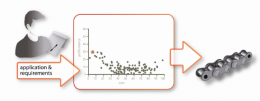Virtual engineer reduces 'transpiration phase' in new designs

When designing new products, a lot of time is lost carrying out repetitive and uninspiring work. In order to shorten this 'transpiration phase' and create more room for real inspiration, University of Twente (Netherlands) PhD student Wouter Schotborgh has developed a software tool capable of swiftly providing a designer with hundreds of alternatives on which to make an informed decision.
This ‘virtual engineer’ is fed with expertise from experienced designers. Schotborgh will be conferred with a PhD from the Faculty of Engineering Technology on 24 April.
Online journey planners and digital electronics shops are readily available to consumers: they are fast, easy-to-use and always accessible. Designers, however, have to rely on product catalogues, formulas and Excel-sheets filled with empirical data. Coming up with a good design takes time, and so the number of alternatives that can be considered is limited. The actual design process can only begin once an intensive search of the catalogues and datasheets has been carried out. This is repetitive work for which an experienced expert has discovered implicit rules and shortcuts, but which according to Schotborgh causes new designers to lose a lot of precious time. He has therefore developed a method that makes the implicit knowledge of experienced designers explicit, and translates it into in software that can generate solutions. Design and optimization can then begin. Up until now, designers have spent a great deal of time analysing.
This new tool helps with the synthesis; the creative phase in which a solution is thought up for the first time. Another benefit is that the knowledge accrued by highly experienced designers will no longer be lost when they leave the organization.
Timetable or journey planner
Schotborgh makes a comparison with old-fashioned timetables: anyone who knows what they are doing soon discovers handy ways of identifying the best connections. But a newcomer spends a lot of time leafing through the pages to compare alternatives. An online journey planner does away with the need to search, presenting several alternatives immediately. Schotborgh’s software helps designers in much the same way. He consults experienced experts not because he wants to become an expert himself or feels the need to devise design algorithms, but to ask direct questions such as ‘what is important?’ and ‘how do you calculate that?’. Two or three consultations are usually all it takes to get to the essence of the knowledge and feed the software with rules.
But the six cases Schotborgh presents in his thesis show that his method also turned out to be an eye-opener for experienced experts. Even designing a simple component like a spring initially requires an extensive search for the best combination of aspects such as performance, price and weight. Pinpointing and clarifying all the options enables the designer to weigh up the deciding factors for the eventual design and make a more informed decision between a standard solution and an innovative strategy.
Provided by University of Twente (news : web)
















